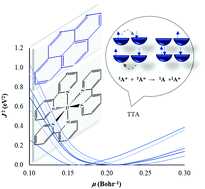Toward photophysical characteristics of triplet–triplet annihilation photon upconversion: a promising protocol from the perspective of optimally tuned range-separated hybrids†
Abstract
The photon upconversion (UC) process assisted by the triplet–triplet annihilation (TTA) mechanism has recently come into the spotlight. Given the rich collection of efforts in this area, theoretical explorations regarding TTA-UC are relatively limited and have proven to be challenging for its control in devices. In this contribution, the photophysical properties crucial for TTA-UC, such as triplet excited state energies and triplet–triplet energy transfer gaps of the essential ingredients involved in the process, namely sensitizers, annihilators and their pairs, have theoretically been investigated using optimally tuned range-separated hybrid functionals (OT-RSHs) and their screened exchange counterparts, OT-SRSHs. Taking a series of experimentally proven-to-work sensitizer/annihilator pairs as working models, we have constructed and validated several variants of OT-RSHs using both full time-dependent and Tamm–Dancoff formalisms for a reliable description of the TTA-UC photophysics. Given the bimolecular biphotonic nature of the TTA-UC process under study, particular attention is paid to the influence of the factors like the underlying density functional approximations and the tunable parameters such as short- and long-range exact-like exchanges as well as the range-separation parameter for both the sensitizers and annihilators separately. Dissecting all the aspects and relying on the appropriate choices from the tested models, we propose an OT-RSH with the correct asymptotic behavior as a cost-effective yet useful tool for this purpose. Not only against the standard RSHs but also in comparison to the conventional hybrids, the newly developed OT-RSH yields a more reliable description for the TTA-UC energetics in the gas phase and dielectric medium. Accountability of the proposed model has further been confirmed for several theoretically designed sensitizer/annihilator pairs prone to be used in the TTA-UC process. Summing up, in light of this study additional pieces of convincing evidence on the quality of OT-(S)RSHs for computational modeling and experimental verifications of the photophysics of the photon UC based on TTA and other possible technologies are showcased.



 Please wait while we load your content...
Please wait while we load your content...